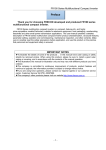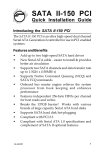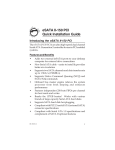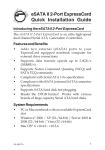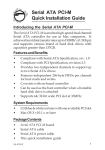Download SIIG Serial ATA 4-Channel PCI Installation guide
Transcript
Serial ATA 4-Channel PCI Quick Installation Guide Introducing the Serial ATA 4-Channel PCI The Serial ATA 4-Channel PCI is an ultra high-speed four channel Serial ATA controller for use in Pentium-class computers. It achieves burst data transfer rates up to 150MB/s (1.5Gb/s) and supports various brand of hard disk drives with capacities greater that 137GB. Features and Benefits • • • • • • • • Compliant with Serial ATA Specification, rev 1.0 Compliant with PCI Specification, revision 2.2 Provides four independent channels to support up to four Serial ATA drives Features independent 256-byte FIFOs per channel for host reads and writes Co-exists with on-board Ultra ATA controller Features Watch Dog timer for fault resiliency Supports 32-bit wide PCI bus at 66MHz Lower pin count and voltage requirement, plus better cabling over traditional Parallel ATA make Serial ATA the controller of the future System Requirements • • • Pentium-class computer with one available PCI slot Windows 98/98SE/ME/NT 4.0/2000/XP/Server 2003 CD-ROM drive (for driver installation) 04-0322B 1 Package Contents • • • • • (1) Serial ATA 4-Channel PCI board (1) Driver CD (2) Serial ATA cable (1) Dual connector Serial ATA power cable This quick installation guide Board Layout Hard Disk LED Pins Serial ATA Connectors CN4 CN3 CN2 CN1 Figure 1. Serial ATA 4-Channel PCI Layout Hardware Installation General instructions for installing the card are provided below. Since the design of computer cases and motherboards vary, refer to your computer’s reference manual for further information, if needed. • Turn OFF the power to your computer and any other connected peripheral devices. Unplug the computer's power cord. 2 • • • Remove your computer’s cover and install the card in an available PCI slot. Push the board down firmly, but gently, until it is well seated. Install a slot bracket holding screw to secure the card. Now go to Device Connection to connect your Serial ATA hard disk drive(s). Device Connection If you plan to use more than two Serial ATA channels, you will need to purchase additional Serial ATA data and power cables. 1. 2. 3. Install hard disk drive(s) into chassis. Connect the Serial ATA hard disk drive to the system power supply using the Serial ATA power cable. Connect one end of the Serial ATA cable to the hard disk drive. Serial ATA cable Serial ATA power cable Figure 3. Hard disk drive connections 4. 5. Attach the other end of the Serial ATA cable to the Serial ATA connector on the board. Follow the same instructions when connecting additional hard drives. Device connection is now complete. 3 Note: If you like to monitor disk activity of the Serial ATA hard drives, you may at this time connect the hard disk LED of the system case to the Hard Disk LED Pins on the Serial ATA controller, see figure 1, on page 2 for the location of the pins. For most systems connect the red wire to the pin farthest from the mounting bracket. 6. Replace the computer cover and reconnect the power cord. Go to Software Installation to install the Serial ATA 4-Channel PCI device driver. Software Installation This section provides information on how to install the Serial ATA 4-Channel PCI drivers for the following operating systems: New & Existing Windows 98/98SE New & Existing Windows ME New & Existing Windows NT 4.0 New & Existing Windows 2000 New & Existing Windows XP/Server 2003 Windows 98/98SE Driver Installation For New Windows 98 Installation 1. Install the board and follow Microsoft procedures to install Windows 98 accordingly. 2. Once Windows has been installed, right click My Computer and click Properties. Select Device Manager tab. 3. Double click PCI Mass Storage Controller listed under Other Devices. 4. Select Driver tab, then click Update Driver button. 4 5. 6. 7. 8. Insert the driver CD and click Next. Select Search for a better driver ... and click Next. Check CD-ROM drive, uncheck the other boxes, then click Next. Click Next again, then Finish. Click Yes to restart Windows to complete the driver installation. For Existing Windows 98 Installation 1. Install the board and boot up Windows 98. 2. At the Add New Hardware Wizard, click Next. 3. Select Search for the best driver for your device and click Next. 4. Insert the driver CD, check CD-ROM drive, uncheck the other boxes, then click Next. 5. Click Next, then Finish. 6. Remove the driver CD and restart Windows to complete the driver installation. Windows ME Driver Installation For New Windows ME Installation 1. Install the board and follow Microsoft procedures to install Windows ME accordingly. 2. Once Windows has been installed, right click My Computer, then click Properties. Select Device Manager tab. 3. Double click PCI Mass Storage Controller listed under Other Devices. 4. Select Driver tab, then click Update Driver button. 5. Insert the driver CD, select Automatic search for a better driver (Recommended), then click Next. 6. Accept the selected driver, then click OK. 5 7. Click Finish, then click Yes to restart Windows to complete the driver installation. For Existing Windows ME Installation 1. Install the board and boot up Windows ME. 2. At the Add New Hardware Wizard, insert the driver CD. 3. Select Automatic search for a better driver (Recommended), then click Next. 4. Accept the selected driver, then click OK. 5. Click Finish, then restart Windows to complete the driver installation. Verify Proper Installation for Windows 98/ME 1. 2. 3. Right-click My Computer, then click Properties. Select Device Manager tab. Double click SCSI controllers and Silicon Image SiI 3114 ... Controller should be listed. Highlight Silicon Image SiI 3114 ... Controller and click Properties. A message This device is working properly is displayed in the dialog box, the driver has been correctly installed. If an error message is displayed, remove Silicon Image SiI 3114 ... Controller and restart your system. Windows NT4.0 Driver Installation A new installation of Windows NT requires a floppy disk for the driver installation. To make this floppy disk, copy the contents of the Floppy folder, found on the driver CD, onto a blank floppy disk then follow the directions below. For New Windows NT4.0 Installation 1. Install the board and follow Microsoft procedures to install Windows NT4.0 accordingly. 6 2. 3. 4. 5. 6. At the Windows NT Setup screen, press F6 to specify and add the driver. Press S, select Other, then press Enter. Insert the driver diskette and press Enter. Select Silicon Image SiI 3114 ... Controller for Windows NT 4.0 and 2000, and press Enter. Press Enter to continue and follow on-screen instructions to complete Windows NT4.0 installation. For Existing Windows NT4.0 Installation 1. Install the board and boot up Windows NT4.0. 2. Double click My Computer/Control Panel/SCSI Adapters, then click the Drivers tab. 3. Click Add … then Have Disk .... 4. Insert the driver CD, type in D:, then click OK. (Assuming D: is your CD-ROM drive) 5. Highlight Silicon Image SiI 3114 ... Controller and click OK. 6. Click OK, remove the driver CD and restart NT to complete the driver installation. Verify Proper Installation for Windows NT4.0 1. 2. Double click My Computer/Control Panel/SCSI Adapters. Highlight Silicon Image SiI 3114 ... Controller from SCSI Adapters listing and click Properties. A message This device is working properly is displayed in the dialog box, the driver has been correctly installed. 7 Windows 2000 Driver Installation A new installation of Windows 2000 requires a floppy disk for the driver installation. To make this floppy disk, copy the contents of the Floppy folder, found on the driver CD, onto a blank floppy disk then follow the directions below. For New Windows 2000 Installation 1. Install the board and follow Microsoft procedures to install Windows 2000 accordingly. 2. Restart your system when prompted during Windows' installation. 3. At the Windows 2000 Setup screen, press F6 to install the driver. 4. Insert the driver diskette. Press S, then press Enter. 5. Select Silicon Image SiI 3114 ... Controller for Windows NT 4.0 and 2000, and press Enter. 6. Press Enter to continue and follow on-screen instructions to complete the installation. For Existing Windows 2000 Installation 1. Install the board and boot up Windows 2000. 2. At the Found New Hardware Wizard, click Next. 3. Select Search for a suitable driver for my device (recommended) and click Next. 4. Insert the driver CD, check CD-ROM drives, uncheck the other boxes, and click Next. Click Next again to continue. Note: If a warning message pops up, click Continue Anyway, then click Finish. Our driver has been thoroughly tested in Windows for stability. 5. 8 Click Finish, remove the driver CD and restart Windows to complete the driver installation. Windows XP/Server 2003 Driver Installation A new installation of Windows XP/Server 2003 requires a floppy disk for the driver installation. To make this floppy disk, copy the contents of the Floppy folder, found on the driver CD, onto a blank floppy disk then follow the directions below. For New Windows XP/Server 2003 Installation 1. Install the board and follow Microsoft procedures to install Windows accordingly. 2. Restart your system when prompted by Windows' installation. 3. At the Windows Setup screen, press F6 to install the driver. 4. Insert the driver diskette. Press S then press Enter. 5. Select Silicon Image SiI 3114 ... for Windows XP/Server 2003, then press Enter. 6. Press Enter to continue and follow on-screen instructions to complete Windows installation. Note: If a Hardware Installation warning pops up, click Yes. Our driver has been thoroughly tested in Windows for stability. For Existing Windows XP/Server 2003 Installation 1. Install the board and boot up Windows. 2. At the Found New Hardware Wizard, insert the driver CD, select Install the software automatically (Recommended), then click Next. 3. Accept the selected driver, then click Next. 9 Note: If a warning message pops up, click Continue Anyway, then click Finish. Our driver has been thoroughly tested in Windows for stability. 4. Remove the driver CD and restart Windows to complete the driver installation. Verify Proper Installation for Windows 2000/XP/ Server 2003 1. 2. 3. 4. Right click My Computer and click Manage. Select Device Manager. Double click SCSI and RAID controllers, then double click Silicon Image SiI 3114 ... Controller to display driver properties. A message This device is working properly is displayed in the dialog box, the driver has been correctly installed. Bios Configuration The Serial ATA 4-Channel PCI BIOS will appear everytime your system starts up. If the bios doesn't show, please try your controller in another PCI slot. During this (Post) process, the bios will show up and indicate the devices attached to it. 10 Technical Support and Warranty QUESTIONS? SIIG’s Online Support has answers! Simply visit our website at www.siig.com and click on Support. Our online support database is updated daily with new drivers and solutions. Answers to your questions could be just a few clicks away. You can also submit questions online and one of our technical support analysts will promptly respond. A lifetime manufacturer warranty supplied with this product is offered by SIIG, Inc. Please see SIIG website for more warranty details. If you should happen to encounter any problems with this product, please follow the procedures below. If it is within the store's return policy period, please return the product to the store where you purchased from. If your purchase has passed the store's return policy period, please follow these steps to have the product repaired or replaced. Step 1: Submit your RMA request. Go to www.siig.com, click Support, then RMA to submit a request to SIIG RMA. If the product is determined to be defective, an RMA number will be issued. SIIG RMA department can also be reached at (510)413-5333. Step 2: After obtaining an RMA number, ship the product. • Properly pack the product for shipping. All software, cable(s) and any other accessories that came with the original package must be included. • Clearly write your RMA number on the top of the returned package. SIIG will refuse to accept any shipping package, and will not be responsible for a product returned without an RMA number posted on the outside of the shipping carton. • You are responsible for the cost of shipping the product to SIIG at the following address: SIIG, Inc. 6078 Stewart Avenue Fremont, CA 94538 RMA #: • SIIG will ship the repaired or replaced product via Ground in the U.S and International Economy outside of the U.S at no cost to the customer. 11 About SIIG, Inc. Founded in 1985, SIIG, Inc. is a leading computer upgrade manufacturer of I/O connectivity products, including PCI & ISA serial and parallel ports, USB, Serial ATA & UltraATA controllers, FireWire (1394a/b), Networking, Sound Cards, and other accessories. SIIG is the premier one-stop source of upgrades. SIIG products offer comprehensive user manuals, many user-friendly features, and are backed by an extensive manufacturer warranty. High-quality control standards are evident by the overall ease of installation and compatibility of our products, as well as one of the lowest defective return rates in the industry. SIIG products can be found in computer retail stores, mail order catalogs, and e-commerce sites in the Americas and the UK, as well as through major distributors, system integrators, and VARs. PRODUCT NAME Serial ATA 4-Channel PCI FCC RULES: TESTED TO COMPLY WITH FCC PART 15, CLASS B OPERATING ENVIRONMENT: FOR HOME OR OFFICE USE FCC COMPLIANCE STATEMENT: This device complies with part 15 of the FCC Rules. Operation is subject to the following two conditions: (1) This device may not cause harmful interference, and (2) this device must accept any interference received, including interference that may cause undesired operation. THE PARTY RESPONSIBLE FOR PRODUCT COMPLIANCE SIIG, Inc. 6078 Stewart Ave. Fremont, CA 94538-3152 Serial ATA 4-Channel PCI is a trademark of SIIG, Inc. SIIG and SIIG logo are registered trademarks of SIIG, Inc. Microsoft and Windows are registered trademarks of Microsoft Corporation. Pentium is a registered trademark of Intel Corporation. Other names used in publication are for identification only and may be trademarks of their respective companies. February, 2005 Copyright ©2005 by SIIG, Inc. All rights reserved.














